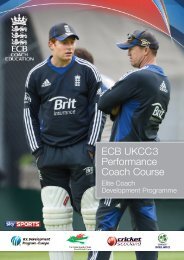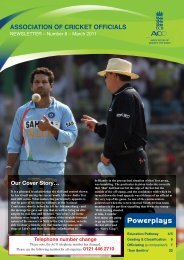ECB ACO Newsletter - Spring 2013
ECB ACO Newsletter - Spring 2013
ECB ACO Newsletter - Spring 2013
Create successful ePaper yourself
Turn your PDF publications into a flip-book with our unique Google optimized e-Paper software.
Blind Cricket T20 World CupPaul Richardson was the <strong>ECB</strong> <strong>ACO</strong>/BCEW representative officiating at the recent T20 Blind World Cup CricketTournament for the Blind. Here Paul gives his views on both the tournament and more generally on this trulyremarkable form of the game.When ‘time’ was called at 3pm on Thursday13 December, it not only signalled the endof the first T20 World Cup tournament forthe blind and a home victory for Indiawhich sparked wild scenes of jubilation forthe thousands of supporters present, it alsomarked the end of a truly incrediblecompetition.Held in Bangalore, the Blind Cricket T20World Cup was without doubt anunprecedented success showcasing the verybest talent in Visual Impaired (VI) cricket.Each match was played in typicalinternational spirit, in the most competitivemanner, without any quarter being askedfor, or given. It must be stressed, however,that the matches were played in atraditionally sporting way, which was verymuch due to the common bond between allplayers, management and officials. Aboveall, the dedication and team spirit shown byall teams was truly exceptional asconsistently evident by the vocal support,encouragement and communication betweenthe players on the field.Nine countries competed – Australia,Bangladesh, England, India, Nepal,Pakistan, South Africa, Sri Lanka and theWest Indies - initially in a round-robingroup format, with each team playing oneanother. The top four teams then proceededto the knock-out semi-finals and the winnersthen played in the final.The group games were played at twogrounds – the Central College Groundsituated in central Bangalore and the AdityaGlobal Sports Ground in Nellamangala whichwas situated about 40kms from the city.For 10 consecutive days, four matcheswere played each day – two at each groundwith one in the morning and the otherfollowing in the afternoon – thus one teamhad a ‘rest’ day. Officials were suppliedfrom England, South Africa, Pakistan, SriLanka, West Indies and India with theumpires standing in one game each day,with no rest days!India and Pakistan VI teams areConducting the tossprofessional teams and were very muchpre-tournament favourites, so it was nosurprise the final paired these two giantsof blind cricket.England started slowly – facing India andPakistan in their first two games andalthough putting up a strong show weresoundly beaten. England, somewhatsurprisingly, lost to Sri Lanka in the thirdgame and then had to be content with a pointfrom a washed-out match againstBangladesh. England then got into theirstride and beat South Africa, Nepal, andAustralia – in the game of the tournamentwinning in the last over – and finallyovercoming the West Indies to meet Pakistanin one of the semi-finals.Unfortunately, Pakistan proved just toostrong but England came out of thetournament having met their targets andwith a glimpse of what could be achieved inthe future.When not umpiring, I spent a lot of timewatching the other matches and over thetwo weeks I spoke with a number of thespectators and sponsors who wereastounded not only by the enthusiasm of theplayers, but by the standard and quality ofthe play - when you see a bowler deliveringan under-arm delivery at a speed not farremoved from red ball medium pace,smashed through the covers towards theboundary, fielded on the ropes by a slidingfielder and returned over the top of thestumps to the keeper, it is hard to imaginethat this has been achieved by players withsuch profound visual impairment.There are two different codes of VIcricket, one is domestic cricket and the otheris the international game. The domestic gameis played with a bigger ball – a size 3 footballwith bowling over-arm. The internationalgame is played with a ball which is the samesize as a normal cricket ball and the bowlingis under-arm. Small ball VI cricket issignificantly different from its big ballbrother: small ball VI cricket is fast, and itrequires a greater skill level. Those playing itare the best VI cricketers and this usuallyalso means their spatial awareness is betterthan the majority of VI individuals.Both forms of VI cricket are a delight toumpire, with impassioned players striving toplay highly competitive matches, the qualityof cricket is fantastically high given thechallenges the players are working around,and the organisation at this level is alsoexcellent.It was my first experience of umpiring amajor tournament and also umpiring in thePaul Richardson leftsub- continent. Each umpire was appointedfor the group games with the only regulationbeing that an umpire could not stand in amatch involving his own nation. This meantthat I umpired matches involving all the othercountries and stood with colleagues fromPakistan, India and an old friend from the2012 Blind Ashes series – Michael Clemensfrom Australia.Once the group-stage was completed, theorganising committee then selected theofficials for the semi-finals and for the finalitself. I was very fortunate and extremelyhonoured to be selected for the Semi final(India v Sri Lanka) and then with ourAustralian friend for the final.The final was unbelievable with around5,000 in attendance at the ground, live TVpictures going to 50 countries and thepredictable frenzy and excitement of an Indiav Pakistan match.Umpiring in the sub-continent had anumber of challenges, notably the heat (andsubsequent hydration problems) but also interms of the light. The ball used was a whiteball which was very difficult to see especiallyin the late afternoon when the sun started togo down.All in all it was a great learning experienceand one I will never forget. For those <strong>ECB</strong><strong>ACO</strong> members who have yet to eitherwitness or indeed officiate in VI cricket, Iwould strongly urge you to get involved. It isa truly humbling, remarkable and enjoyableform of the game. In addition, it alsodevelops a number areas of our work,notably, the variations in regulations requirevery high concentration levels, verbalcommunication needs to be absolutely clearand concise, and as for gaining experiencewith runners, what better way than havingtwo B1 batsmen and their respective runnersout in the middle at the same time?I would recommend VI cricket to any<strong>ACO</strong> member.Paul Richardsone-mail us at ecbaco@ecb.co.uk 10 contact us on 0121 446 2710












![Indoor Sports Halls with Cricket Provision [TS3] - Ecb - England and ...](https://img.yumpu.com/49070696/1/190x135/indoor-sports-halls-with-cricket-provision-ts3-ecb-england-and-.jpg?quality=85)



